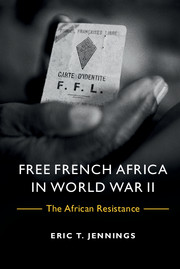Book contents
- Frontmatter
- Contents
- Figures
- Maps
- Acknowledgments
- Archival Abbreviations
- Glossary
- Introduction
- PART I FREE FRANCE'S AFRICAN GAMBIT
- PART II THE WAR
- Introduction to Part II
- 4 The Empire Strikes Back
- 5 Free French Africa in Arms
- PART III RESOURCE EXTRACTION, WARTIME ABUSES, AND AFRICAN EXPERIENCES
- Epilogue
- Conclusion
- Bibliography
- Index
Introduction to Part II
from PART II - THE WAR
Published online by Cambridge University Press: 05 August 2015
- Frontmatter
- Contents
- Figures
- Maps
- Acknowledgments
- Archival Abbreviations
- Glossary
- Introduction
- PART I FREE FRANCE'S AFRICAN GAMBIT
- PART II THE WAR
- Introduction to Part II
- 4 The Empire Strikes Back
- 5 Free French Africa in Arms
- PART III RESOURCE EXTRACTION, WARTIME ABUSES, AND AFRICAN EXPERIENCES
- Epilogue
- Conclusion
- Bibliography
- Index
Summary
The following chapters do not aspire to cover the totality of military operations involving FEA and Cameroonian forces. Several narratives penned by both historians and participants have already traced the main battles in question. In addition, I have chosen explicitly to privilege African and colonial dimensions. This has proven challenging, for the archives rarely distinguish troops from the territories in question from other colonial forces. While some bataillons de marche, the basic military unit in Free French Africa, hailed from Oubangui-Chari, Chad, Cameroon, and Congo, the constant retooling of units in 1940 and then again in 1943 renders it nearly impossible to isolate FEA and Cameroonian elements in Free French ranks. Far from simplifying the task, labels typically prove misleading. Thus, the famous B.M. 2, known as the Oubangui battalion, included many Cameroonians and Chadians, and was probably comprised of roughly 50 percent ethnic Saras. The régiment des tirailleurs sénégalais du Tchad counted more Chadians than Senegalese. In fact, the latter was a term most often used at the time to designate all African troops.
Calculating totals for Free French forces has proven equally delicate, all the more so for African troops for which much less individual information is available (consider the records for Africans in the prestigious Ordre de la Libération whose files are incommensurably thinner than those of their European peers). To further complicate matters, sub-Saharan African soldiers do not systematically appear on Free French databases, like the one drawn up by Free French veteran Henri Ecochard. Jean-François Muracciole has rightly suggested that while Ecochard's document is reliable for European volunteers, it is far less exhaustive for colonial recruits. This is due in large part to the ways in which the latter were recruited and the resulting absence of a paper trail.
The question of sources is crucial here, all the more so because so few African officers and NCOs – and even fewer soldiers – have left memoirs. Sergeant Rapahël Onana constitutes an interesting exception. His rich account reveals a certainty, ingrained by his mother, that he was “armored” at birth in rural Cameroon in 1919 against a premature death. No doubt this confidence came in handy during the three campaigns in which Onana fought: in Gabon in 1941, the Middle East in 1941, and at the battle of Bir Hakeim against Rommel's forces in 1942.
- Type
- Chapter
- Information
- Free French Africa in World War IIThe African Resistance, pp. 111 - 113Publisher: Cambridge University PressPrint publication year: 2015



